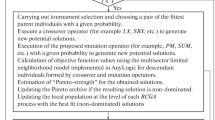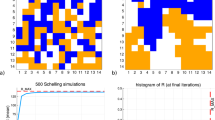Abstract
This study explores a possible segregation mechanism assuming fuzzy group membership. We construct a fuzzy set extension of Schelling’s spatial segregation model. In the fuzzy Schelling model, each agent is assumed to have fuzzy membership in groups, which is typically assumed to represent the strength of the agent’s group identity. The model assumes that agents want to be with agents with the same or stronger (less fuzzy) group identity than themselves. Agents decide whether to stay or move depending on whether their neighborhood satisfies their desires. Analyzing a series of simulations reveals that: First, the fuzzy Schelling model can reproduce segregation at the macro level; here, segregation is formed by the accumulation of agents’ modest desires and actions. This is the most important property of the Schelling model. Second, agents’ behavior and situation differ depending on the fuzziness of their membership. Notably, agents with less fuzzy membership play an important role in the system’s equilibrium. Third, the tendency to reach equilibrium differs depending on the density of the space, required similarity level in the neighborhood, and initial distribution of membership values. Finally, we discuss the implications of the results.










Similar content being viewed by others
Data Availability
This study does not use any empirical data.
Notes
As Fig. 11 in the Appendix shows, 200 steps are sufficient to reach equilibrium for most crisp Schelling model configurations. The long-term behavior of fuzzy Schelling models that do not reach equilibrium within 200 steps will be the subject of future research.
For example, suppose that an agent with a membership value of 1 somehow reaches a neighborhood where four agents have membership value 1 and other four have a membership value 0. If the required similarity rate p is less than or equal to 0.5, then the agent can stay at the place as long as none of the other neighbors move elsewhere. In this situation, according to the definition of the measurement, the neighborhood similarity of the agent s(x) is 0.5, and the neighborhood fuzziness of the agent \(\phi (x)\) is 0, indicating low neighborhood similarity and less neighborhood fuzziness.
References
Brewer, M. B., & Pierce, K. P. (2005). Social identity complexity and outgroup tolerance. Personality and Social Psychology Bulletin, 31(3), 428–437. https://doi.org/10.1177/0146167204271710
Brown, R. (2000). Social identity theory: Past achievements, current problems and future challenges. European Journal of Social Psychology, 30(6), 745–778. https://doi.org/10.1002/1099-0992(200011/12)30:6<745::AID-EJSP24>3.0.CO;2-O
Bruch, E. E., & Mare, R. D. (2006). Neighborhood choice and neighborhood change. American Journal of Sociology, 112(3), 667–709. https://doi.org/10.1086/507856
Clark, W. A. V., & Fossett, M. (2008). Understanding the social context of the Schelling segregation model. Proceedings of the National Academy of Sciences, 105(11), 4109–4114. https://doi.org/10.1073/pnas.0708155105
De Luca, A., & Termini, S. (1972). A definition of a nonprobabilistic entropy in the setting of fuzzy sets theory. Information and Control, 20(4), 301–312. https://doi.org/10.1016/S0019-9958(72)90199-4
Flache, A., & de Matos Fernandes, C. A. (2021). Agent-based computational models, In G. Manzo (Ed.) Research Handbook on Analytical Sociology, Research Handbooks in Sociology, (pp. 453–473). Edward Elgar Publishing. https://doi.org/10.4337/9781789906851.00033.
Fossett, M. (2006). Ethnic preferences, social distance dynamics, and residential segregation: Theoretical explorations using simulation analysis. The Journal of Mathematical Sociology, 30(3–4), 185–273. https://doi.org/10.1080/00222500500544052
Fossett, M. (2011). Generative models of segregation: Investigating model-generated patterns of residential segregation by ethnicity and socioeconomic status. The Journal of Mathematical Sociology, 35(1–3), 114–145. https://doi.org/10.1080/0022250X.2010.532367
Grantham, E. O., & Giabbanelli, P. J. (2020). Creating perceptual uncertainty in agent-based models with social interactions. In 2020 Spring Simulation Conference (SpringSim) (pp. 1–12).
Hazan, A., & Randon-Furling, J. (2013). A Schelling model with switching agents: Decreasing segregation via random allocation and social mobility. The European Physical Journal B, 86(10), 421. https://doi.org/10.1140/epjb/e2013-31142-1
Hegselmann, R. (2017). Thomas C. Schelling and James M. Sakoda: The intellectual, technical, and social history of a model. Journal of Artificial Societies and Social Simulation, 20(3), 15. https://doi.org/10.18564/jasss.3511
Ishida, A. (2016). Imagined conditions of the “Japanese’’: Social category analysis of internet survey data. Japanese Sociological Review, 67(2), 182–200. https://doi.org/10.4057/jsr.67.182
Jones, N., Marks, R., Ramirez, R. & Ríos-Vargas, M. (2021). Improved race and ethnicity measures reveal U.S. population is much more multiracial. [Online] https://www.census.gov/library/stories/2021/08/improved-race-ethnicity-measures-reveal-united-states-population-much-more-multiracial.html. Accessed 1 Aug 2023.
Leszczensky, L., & Pink, S. (2019). What drives ethnic homophily? A relational approach on how ethnic identification moderates preferences for same-ethnic friends. American Sociological Review, 84(3), 394–419. https://doi.org/10.1177/0003122419846849
Levy, A., Saguy, T., van Zomeren, M., & Halperin, E. (2017). Ingroups, outgroups, and the gateway groups between: The potential of dual identities to improve intergroup relations. Journal of Experimental Social Psychology, 70, 260–271. https://doi.org/10.1016/j.jesp.2016.09.011
Liu, Z., Li, X., Khojandi, A., & Lazarova-Molnar, S. (2019). On the extension of Schelling’s segregation model. In 2019 Winter Simulation Conference (WSC) (pp. 285–296).
Perlmann, J., & Waters, M. C. (Eds.). (2002). The new race question: How the census counts multiracial individuals. Russell Sage Foundation.
Sakoda, J. M. (1971). The checkerboard model of social interaction. The Journal of Mathematical Sociology, 1(1), 119–132. https://doi.org/10.1080/0022250X.1971.9989791
Schelling, T. C. (1971). Dynamic models of segregation. The Journal of Mathematical Sociology, 1(2), 143–186. https://doi.org/10.1080/0022250X.1971.9989794
Schelling, T. C. (1978). Micromotives and macrobehavior. W. W. Norton & Company.
Silver, D., Byrne, U., & Adler, P. (2021). Venues and segregation: A revised Schelling model. PLoS One, 16(1), 1–35. https://doi.org/10.1371/journal.pone.0242611
Smithson, M., & Verkuilen, J. (2006). Fuzzy set theory: Applications in the social sciences. Sage Publications.
Urselmans, L., & Phelps, S. (2018). A Schelling model with adaptive tolerance. PLoS One, 13(3), 1–24. https://doi.org/10.1371/journal.pone.0193950
Verkuyten, M. (2018). The social psychology of ethnic identity (2nd ed.). Routledge.
Vinković, D., & Kirman, A. (2006). A physical analogue of the Schelling model. Proceedings of the National Academy of Sciences, 103(51), 19261–19265. https://doi.org/10.1073/pnas.0609371103
Woo, Y. (2022). Homogenous Japan? An empirical examination on public perceptions of citizenship. Social Science Japan Journal, 25(2), 209–228. https://doi.org/10.1093/ssjj/jyac001
Xie, Y., & Zhou, X. (2012). Modeling individual-level heterogeneity in racial residential segregation. Proceedings of the National Academy of Sciences, 109(29), 11646–11651. https://doi.org/10.1073/pnas.1202218109
Young, H. P. (1998). Individual strategy and social structure: An evolutionary theory of institutions. Princeton University Press.
Zadeh, L. A. (1965). Fuzzy sets. Information Control, 8, 338–353. https://doi.org/10.1016/S0019-9958(65)90241-X
Zhang, J. (2004). A dynamic model of residential segregation. The Journal of Mathematical Sociology, 28(3), 147–170. https://doi.org/10.1080/00222500490480202
Zhang, J. (2004). Residential segregation in an all-integrationist world. Journal of Economic Behavior & Organization, 54(4), 533–550. https://doi.org/10.1016/j.jebo.2003.03.005
Zhang, J. (2011). Tipping and residential segregation: A unified Schelling model. Journal of Regional Science, 51(1), 167–193. https://doi.org/10.1111/j.1467-9787.2010.00671.x
Acknowledgements
I am grateful to the two anonymous reviewers for valuable suggestions that helped improve this article. This study was supported by JSPS KAKENHI Grant Number 19K02065, 23K01808.
Author information
Authors and Affiliations
Corresponding author
Ethics declarations
Conflict of interest
The author states that there is no conflict of interest.
Supplementary information
The animation of the simulation of Fig. 3 and the Python code for the simulation is available at the author’s GitHub repository (https://github.com/aishidajt9/fuzzySchelling).
Additional information
Publisher's Note
Springer Nature remains neutral with regard to jurisdictional claims in published maps and institutional affiliations.
Google Scholar profile: https://scholar.google.com/citations?user=ZqUoqwoAAAAJ.
Rights and permissions
Springer Nature or its licensor (e.g. a society or other partner) holds exclusive rights to this article under a publishing agreement with the author(s) or other rightsholder(s); author self-archiving of the accepted manuscript version of this article is solely governed by the terms of such publishing agreement and applicable law.
About this article
Cite this article
Ishida, A. A fuzzy set extension of Schelling’s spatial segregation model. J Comput Soc Sc (2023). https://doi.org/10.1007/s42001-023-00234-7
Received:
Accepted:
Published:
DOI: https://doi.org/10.1007/s42001-023-00234-7












